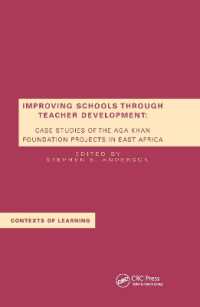- ホーム
- > 洋書
- > 英文書
- > Business / Economics
Full Description
Compiled from 10 years of research, with chapters contributed by experts in the field, we demonstrate how tourism will benefit from applying a new paradigm found in mainstream psychology, termed here the 'Cognitive Wave'. Tourism professionals who apply this will benefit by identifying how they apply concepts such as attention, emotion, sensations, and memory in their work, and critically understand how to measure them.
The work is arranged into five sections. Section 1 introduces the 'Cognitive Wave' and discusses the potential advantages and disadvantages. Section 2 introduces the mental processes central to cognition. Sections 4 and 5 provide examples of disambiguation, translating tourism concepts and theories into those of cognitive psychology.
Every chapter highlights relevant existing research and opportunities for further developments. Real-world examples of the application of theory and methods to tourism, hospitality, events, leisure, and service fields are provided. There are many opportunities for developing these, and other topics, further and in developing the work of the invisible college which underpins the silent shift to the 'Cognitive Wave'.
Contents
SECTION I. Introduction to the Cognitive Approach
Chapter 1. Introduction
Chapter 2. Cognitive Science and Tourism
Chapter 3. The Cognitive Wave: Major Concepts
Chapter 4. Updating Tourism Theory: The S-O-R Model
Chapter 5. Conceptual Disambiguation
SECTION II. Processes
Chapter 6. Sensation and Perception
Chapter 7. Consciousness
Chapter 8. Emotions
Chapter 9. Motivation and Goals
Chapter 10. Novelty and Tourism
Chapter 11. Memory
Chapter 12. Memory Schema
Chapter 13. Prospection and Tourism
Chapter 14. Coping Strategy and Negative Emotions
SECTION III. Applications
Chapter 15. Experience Design
Chapter 16. Experience Co-Creation: Attention and Involvement
Chapter 17. Inspiring Awe in Immersive Nature Tourism Experiences
Chapter 18. Mindfulness and Tourism
Chapter 19. Why Stories Work
SECTION IV. Methods
Chapter 20. Eye-Tracking in Tourism
Chapter 21. Neuroscience for Tourism Research
Chapter 22. Direct Effects Of Tourism Commercials: Skin Conductance Methods
SECTION V. Conclusion
Chapter 23. A Cautionary Tale
Chapter 24. Conclusion






